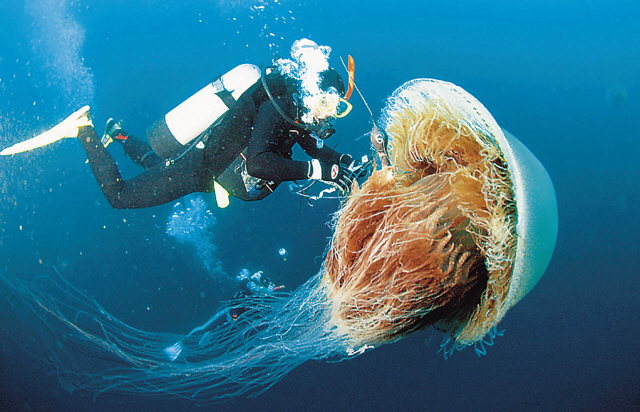
Holidaymakers and fishermen are worried about giant toxic jellyfish showing up in Korea’s coastal areas in record numbers this summer.
A girl was killed earlier this month and more than 500 people have been stung by jellyfish in the seas around Busan this season. The southern resort island of Jeju saw more than 130 people stung.
Although there have been reports in China and Southeast Asia of deaths caused by poisonous jellyfish, Korea was considered relatively safe from them.
However, the scare is spreading following the recent surge in accidents, including the first death associated with jellyfish.
“The number of jellyfish species that can be found in Korea is 124, and among them 100 are poisonous. Thus Korea is no longer a safe zone. Furthermore, the most frequently seen are Nomura’s jellyfish and moon jellyfish,” said Yoon Won-duk, a researcher at National Fisheries Research and Development Institute.
According to Yoon, the one that killed the girl is most likely Nomura’s jellyfish.
Last year, nuclear power plants in Scotland, Japan, Israel and Florida were forced to shut down because the free-moving animals were clogging the water inlets.

The swarming of jellyfish has been predicted by many experts since early 2000. In 2002, Japan saw blooms of jellyfish in its coastal waters, and in 2009 Australian marine scientist Anthony Richard foresaw a near future in which marine biodiversity would be dominated by jellyfish.
Experts give several causes to the somewhat sudden global increase of jellyfish, all of which have to do with the changing oceanic environment. Warmer temperatures caused by global warming, salinity changes, ocean acidification and pollution all help jellyfish thrive.
“Not only higher ocean temperature but also overfishing and pollution have increased the jellyfish population. As the temperature rises even further, more jellyfish will be moving northward,” said Yoon.
There are still some weeks left until the summer heat wanes, and in the meantime, beaches will still be the favorite destinations of people on vacation.
If one is stung by jellyfish, a few measures can be taken to alleviate the situation.
First, get the person out of the water and wash the spot immediately with seawater or running water. Do not rinse with vinegar unless stung by Jimble; it can reactivate stinging cells. Apply tetracycline cream to relieve itching and swelling and use ice packs to relieve sever pain or welts. Call 119 if the person displays signs of a severe allergic reaction.
By Kim Jung-ho (jungho1991@gmail.com)
A girl was killed earlier this month and more than 500 people have been stung by jellyfish in the seas around Busan this season. The southern resort island of Jeju saw more than 130 people stung.
Although there have been reports in China and Southeast Asia of deaths caused by poisonous jellyfish, Korea was considered relatively safe from them.
However, the scare is spreading following the recent surge in accidents, including the first death associated with jellyfish.
“The number of jellyfish species that can be found in Korea is 124, and among them 100 are poisonous. Thus Korea is no longer a safe zone. Furthermore, the most frequently seen are Nomura’s jellyfish and moon jellyfish,” said Yoon Won-duk, a researcher at National Fisheries Research and Development Institute.
According to Yoon, the one that killed the girl is most likely Nomura’s jellyfish.
Last year, nuclear power plants in Scotland, Japan, Israel and Florida were forced to shut down because the free-moving animals were clogging the water inlets.

The swarming of jellyfish has been predicted by many experts since early 2000. In 2002, Japan saw blooms of jellyfish in its coastal waters, and in 2009 Australian marine scientist Anthony Richard foresaw a near future in which marine biodiversity would be dominated by jellyfish.
Experts give several causes to the somewhat sudden global increase of jellyfish, all of which have to do with the changing oceanic environment. Warmer temperatures caused by global warming, salinity changes, ocean acidification and pollution all help jellyfish thrive.
“Not only higher ocean temperature but also overfishing and pollution have increased the jellyfish population. As the temperature rises even further, more jellyfish will be moving northward,” said Yoon.
There are still some weeks left until the summer heat wanes, and in the meantime, beaches will still be the favorite destinations of people on vacation.
If one is stung by jellyfish, a few measures can be taken to alleviate the situation.
First, get the person out of the water and wash the spot immediately with seawater or running water. Do not rinse with vinegar unless stung by Jimble; it can reactivate stinging cells. Apply tetracycline cream to relieve itching and swelling and use ice packs to relieve sever pain or welts. Call 119 if the person displays signs of a severe allergic reaction.
By Kim Jung-ho (jungho1991@gmail.com)

















![[KH Explains] Hyundai's full hybrid edge to pay off amid slow transition to pure EVs](http://res.heraldm.com/phpwas/restmb_idxmake.php?idx=652&simg=/content/image/2024/04/18/20240418050645_0.jpg&u=20240418181020)

![[Today’s K-pop] Zico drops snippet of collaboration with Jennie](http://res.heraldm.com/phpwas/restmb_idxmake.php?idx=642&simg=/content/image/2024/04/18/20240418050702_0.jpg&u=)